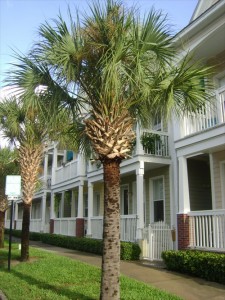Sabal Palm Trees
 The Sabal Palm is also known as a Sabal Palmetto or Cabbage Palm and is native to the Bahamas, Cuba and the southeastern portion of the United States. The state tree of both South Carolina and Florida, it originally grew near the coast of the Florida Panhandle in the vicinity of St. Andrews Bay. It is now included in many distinctive landscapes in Florida because of its beauty, tolerance to winds and salt air, cold hardiness and drought or hurricane resistance. Having a calming influence, these palms have been planted along the freeways by the State of Florida to absorb noise and create a peaceful environment.
The Sabal Palm is also known as a Sabal Palmetto or Cabbage Palm and is native to the Bahamas, Cuba and the southeastern portion of the United States. The state tree of both South Carolina and Florida, it originally grew near the coast of the Florida Panhandle in the vicinity of St. Andrews Bay. It is now included in many distinctive landscapes in Florida because of its beauty, tolerance to winds and salt air, cold hardiness and drought or hurricane resistance. Having a calming influence, these palms have been planted along the freeways by the State of Florida to absorb noise and create a peaceful environment.
| Names | Sabal Palm, Cabbage Palm |
| Plant Type | Palm Tree |
| Hardiness Zones | 8-10 |
| Light Needs | Full sun to partial shade |
| Water Needs | Drought Tolerant |
| Soil Needs | Moist, Well-Drained |
| Cold Tolerance | Cold Hardy |
Growing up to a height of 65 feet or taller, its trunk can measure 2 feet in diameter. The crown of the Sabal Palm can grow 12 to 18 feet in diameter, and when grown in shade, is often wider. Planting in the sun makes it somewhat more compact. Adapting to most soil, the Sabal Palm can be planted at beach side settings, as well as in other landscapes in Zone 8-10. It thrives in full sun or some shade. If grown in mostly shade, the trunk will be somewhat narrower. It tolerates drought and is quite adaptable. Standing in water or still water is tolerated by this palm, though average moisture is desired. The Sabal Palm tolerates freezing, and if the temperature falls well below 32 degrees, it will survive.
The blooms of this palm are a yellow-white, approximately .20 inches across and form groups of flowers. The fruit is black and contains a single seed. Local Seminole Indians of Florida used the palm fronds of the Sabal Palm to create huts called Chickee huts: The huts are sometimes used as design idea in present day architectural decor. Pathways created by the Sabal Palm are often seen in the Orlando and Tampa area, as many hotels line their entrance with this distinctive palm.
It ornamental beauty, calming presence and hardiness make the Sabal Palm a perfect addition to any landscape in the Tampa or Western Florida area.
They can also be found in abundance in places trying to restore Tampa Bay’s natural habitat such as the Tampa Bay Mitigation Bank.





